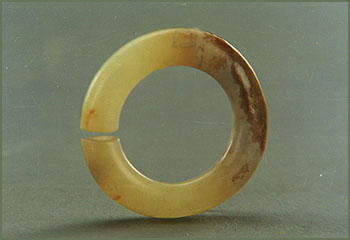Xinglongwa Culture is a culture of the early stages of the
Neolithic Age in Inner Mongolia with a wide coverage that stretches
to Xunhe in the west, Yiwulu Mount in the east, Wuerjimulun River
in the north and the northern coast of Bohai Sea in the south.
The relics of Xinglongwa Culture are located at a tableland 1.5
kilometers to the southeast of Xinglongwa Village of Baoguotu
Township, Aohan Banner, Chifeng, Inner Mongolia. The six rounds of
excavations at Xinglongwa relics have discovered ruins of 170
houses and more than 30 graves, which took the lead in China in
revealing all the traces of habitation, including ditches, ruins of
houses and cave dwellings of the people of a pre-historic
tribe.
The evolution of the habitation at Xinglongwa goes through three
stages. Houses of the first stage are comparatively spacious,
distributed in lines from the northeast to the southeast and
surrounded by elliptical ditches. Houses of the second stage follow
their predecessors in arrangement but with smaller areas; houses of
the third stage are disorderly and more densely arranged with still
smaller areas, indicating the considerable prosperity of the tribes
of Xinglongwa.
The graves of Xinglongwa relics are an essential component of
Xinglongwa Culture, and the number and location of these graves
suggest that they are related to the sacrificial activities of the
people of that time. In one of the graves, we can find that the
dead was buried side by side with two pigs, one male and the other
female, which leads to our assumption that due to his social status
and extraordinary cause of death, the dead was taken by his fellow
tribesmen as the object of worship and sacrificial rites so that
they could be blessed by certain kind of supernatural power. The
pigs buried alongside the dead indicate that the offering of
sacrifices to ancestors was combined with those to the preys, and
the offering of sacrifice by the inhabitants of Xinglongwa to the
spirit of pig is considered to be of the significance of totem
worship. The large numbers of bones of deer, pigs and other animals
unearthed at the ruins of houses and among the funerary subjects is
another proof to the fact that hunting economy was in the dominant
position in people's life at that time.
The dozens of jade articles unearthed at Xinglongwa site shows
that the people of Xinglongwa were aware of the selection of
materials-most of the artifacts were made from pale green,
yellowish green, milky white or light white materials, and that
they had gained knowledge of polishing and boring. As the earliest
genuine jade articles known to us in China so far, the artifacts
unearthed at Xinglongwa site have marked the completion of the
division of labor of the society, shifted the time of the use of
ground genuine jade articles in China to the middle of Neolithic
Age as far away as 8,000 years ago, and provided a direct origin
for the jade articles of Hongshan Culture.
 |
The potteries unearthed at Xinglongwa are without exception
sand-mixed ones, most of which are of loose quality, heavy
roughcast and inadequate degree of forging, with grayish brown or
yellowish brown exteriors and dark gray interiors. The decorative
stripes outside are mostly pressed ones in the patterns of
horizontal "^", "Z", woven mats and grids. All the potteries are
manually made.
The stoneware found in the relics of Xinglongwa consists
typically of chipped stone hoes and axe-shaped implements.
Kernels of juglans mandshurica, an arbor usually found in mixed
forests of deciduous broad leaf trees and coniferous trees, which
are typical in temperate zones, were unearthed at the earlier
relics of Xinglongwa, indicating the warm and humid climate that is
in sharp contrast to the arid climate of grassland and desert.
Xinglongwa Culture is one of the three major cultural systems of
northern China, the discovery of which demonstrates that the
culture of Neolithic Age in Inner Mongolia is of a long history. As
the origin of Hongshan Culture, Xinglongwa Culture plays a
significant role in revealing the characteristic aboriginality and
continuity of the Neolithic cultures at the eastern part of the
Great Wall and helps determine the historic position of the culture
in interacting with the Neolithic cultures in the Huanghe River
valley and in promoting the progress of the culture of the whole
northeastern China.